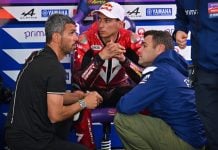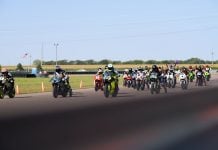Pietro Caprara, born in 1967, is the Chief Technician of JiR Team Scot in MotoGP. He has extensive experience in world competition, which began in 1996 with the Yamaha YZR500 in the Blue Riband class before moving to MotoGP with Team Yamaha and then Aprilia where he spent three years in the 250cc category. His extensive experience makes for an interesting interview as to how things have changed over the years from 500cc two-strokes to the MotoGP four-strokes and what a technician can do to put their rider in a position to win. Pietro Caprara Chief Technician, JiR Team Scot Since the mid-seventies, two-strokes dominated the 500 class, before the four-strokes came along at the end of 2001. What are the characteristics and differences between the two technologies? “The differences between the two types of motors have both construction implications and mechanical, environmental, how the motorcycle is driven, as well as construction and maintenance cost issues. Mechanically the two-stroke engine is simple, the piston, with its alternating motion, opens and closes the ports of the intake and exhaust from which the mixture of air/petrol and oil and exhaust gases enters and leaves. In comparison, the four-stroke motor is complex and heavier than its two-stroke equivalent. The upper part of the engine is the ‘head’, which holds the intake and exhaust valves, driven by camshafts. Engine power comes from petrol shot into the engine via injectors. The lubrication of the two-strokes engine, crankshaft and connecting rods, is entrusted to the fuel. The power is normally governed by a carburettor that has a mechanical operation typically controlled by the depression created by the movement of the piston. The lubrication of the various mechanisms of the four-strokes is entrusted to oil and this can be collected in a reservoir, built in the lower part of the engine called a sump, which can either be a ‘dry’ or ‘wet’ sump depending on whether the oil is collected in a separate tank.” How have these differences changed the way you work in the pit garage? “The maintenance and alteration of a two-stroke is very different from a four-stroke and can be carried out completely in the field, given the simple nature of its construction. Historically these changes used to be made by the team, even in satellite squads. The maintenance of the four-stroke is complex and only factory technicians are entrusted to work on the engine, while mechanics from satellite teams are only allowed to do maintenance that doesn’t involve opening up the engines.” So, with these two very different technological characteristics with these powerplants, what are the different feelings for the rider using them? “The peculiarity of the two-stroke engine, in principle, is that it produces very little torque low down in the rev range but lots at high revs. In 500ccGPs maximum torque was very close to that of maximum power on the rev counter, but in modern MotoGP the release of both torque and power is more linear and more progressive and so is more exploitable and has wider powerband than that of a two-stroke. To give the two-stroke more flexibility exhaust powervalves were adopted to broaden where the power and torque came in, giving more drive when you opened the gas. The differences on the track were that riding the two-strokes smoothness on the throttle and through the corner was the best way to ride and the bike had almost no engine braking and the weight of the machine was lower too. In MotoGP you can break the smooth trajectory through the corner as you’ve so much torque and power, you can accelerate away out of the turn. With a 500, the acceleration phase was the most delicate operation, because the violence with which the power came in meant that rider error would lead to sudden loss of adhesion of the rear tyre and a subsequent classic high-side. The two-stroke motorcycles required sensitivity from the rider: especially on the throttle. With the four-strokes, the relatively large amount of power is offset by the electronic management and traction control system. This year for example, beginners in the MotoGP class coming from the 250cc two-stroke category have adapted quickly, getting good results in the race, although they are generally the riders who have been the best in the category they have just left.” 2002 was the year of the MotoGP four-stroke engine debut. Doubts and misgivings have now melted away, but what’s the difference in working with these motors from the view in the pit garage? “Since this ‘new adventure’ there were unknowns, not only to the development of the motorcycle but this new technology also demanded a different way of working from the team. From an operational point of view, in the pit-box, things will work in a different way; on four-strokes you will do things or work on parameters that on the two strokes were less present. The typical example is the electronic management system, which on four-strokes is crucial, whereas with two-strokes you would be spending time opening the engines and changing cylinders and pistons. So today the technicians and mechanics now concentrate much more on the development of the set-up of the bike and on tyres. It would seem that the amount of work in the pits has declined and that everything is now delegated to specialist electronics. Is that right? “We don’t now ‘work less’ as we have less to do with the motor, instead the areas in which we work have changed. We work hard and the skills of the mechanics and the competitive nature of our work means the riders are chasing vital parts of a second and we need to be looking at the smallest details. To get even a single tenth of time on the track is essential. That’s the real competition that takes place inside the pit-box.”
Interview With JiR Team Scot Honda Chief Technician Pietro Caprara
Interview With JiR Team Scot Honda Chief Technician Pietro Caprara
© 2008, Roadracing World Publishing, Inc.





